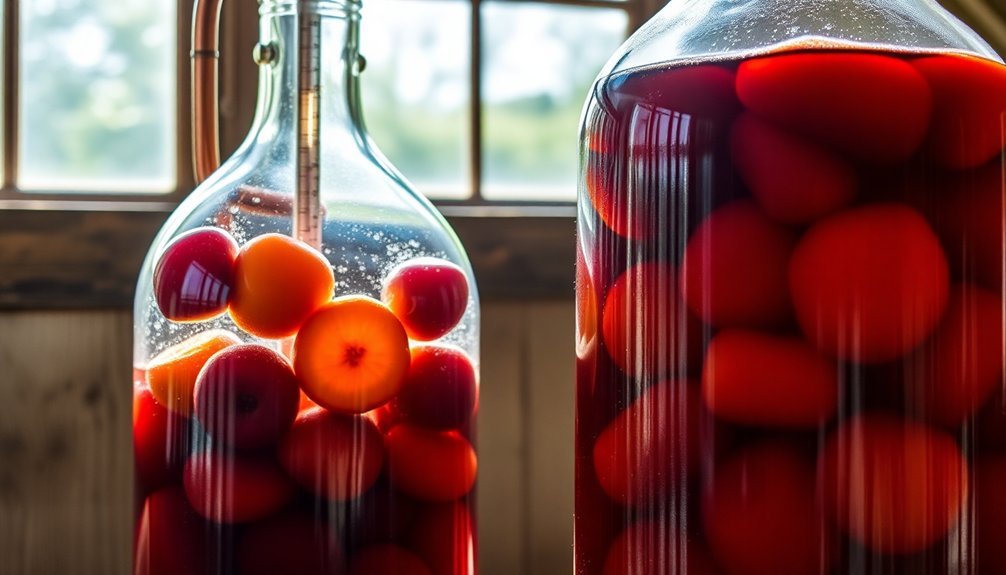There are five proven methods to transform fresh fruit into sophisticated brandied delicacies. You'll find success with cold maceration before distillation for enhanced flavor extraction, or try the direct spirit infusion method using brandy or vodka as your base. The double fermentation technique creates a refined spirit through two distinct phases, while the whole fruit submersion process offers a straightforward approach for home preserving. For a traditional twist, the layered sugar preservation method uses osmosis to create rich, brandied preserves. Each technique brings its own unique characteristics to your finished product, and there's much more to discover about these time-honored preservation methods.
Cold Maceration Before Distillation

After fermentation, you're ready to distill your fruit mash.
Cold soaking the fruit beforehand enhances the flavor extraction for a superior brandy.
During distillation, separate the heads and tails from the hearts fraction.
The hearts will then age in oak barrels to develop your brandy's final complexity and character.
Direct Spirit Infusion Method
The direct spirit infusion method offers a simpler alternative to traditional brandy-making techniques. You'll want to start by selecting brandy as your base spirit, as its complex notes naturally complement fruit flavors. However, you can also use vodka if you're seeking a purer fruit expression in your final product.
Begin by preparing your fresh fruit carefully. Remove any blemished areas and cut the fruit into manageable chunks. Using a sharp knife makes the preparation process more efficient and precise. If you're working with firmer fruits like apples, you'll need to puree them in a blender, adding a small amount of water if necessary. Strain the puree to remove excess pulp.
Place your prepared fruit in a clean jar and pour your chosen spirit over it, making sure the fruit is completely submerged. Seal the container tightly and store it in a cool, dark place. You'll need to shake the jar daily to encourage proper flavor extraction.
Monitor your infusion by tasting it regularly. Most fruit infusions take 2-4 days to reach ideal flavor, though you might prefer to let it develop longer. Once you're satisfied with the taste, strain the mixture through cheesecloth to achieve a clear final product.
Double Fermentation Technique

While direct spirit infusion provides quick results, mastering the double fermentation technique yields a more authentic and complex fruit brandy.
You'll start by fermenting fresh fruit juice into a low-alcohol wine, allowing the natural flavors and aromatics to develop fully. This initial fermentation creates what's known as "low wines," which become the foundation for your brandy. Charentais alembics have traditionally been the gold standard for this process.
The magic happens during the second fermentation and subsequent distillations. You'll need copper pot stills, preferably with a double-boiler setup, to preserve the delicate flavor compounds while preventing the fruit solids from burning. The process transforms your low wines into a refined spirit with approximately 70% alcohol content.
Follow these critical steps for ideal results:
- Use ripe, fresh fruit and ferment until you've achieved complete sugar conversion
- Perform your first distillation slowly to capture essential aromatics
- Control temperature carefully during the second distillation to concentrate flavors
- Age the final spirit in oak barrels for at least two years
You'll need to add water after aging to achieve your desired alcohol content, and you may choose to blend different batches for consistency in flavor and character.
Whole Fruit Submersion Process
Creating fruit-infused brandy through submersion requires careful attention to both fruit selection and preparation techniques.
You'll want to select ripe, fresh fruits known for their rich flavors and sugar content, such as apples, pears, or grapes. Before submersion, remove any stems, leaves, and blemished areas from your fruit. For ideal results, you'll need to process the fruit appropriately – mash bananas into quarter-inch chunks or puree apples with a small amount of water.
To begin the submersion process, place your prepared fruit in a clean glass jar and cover it completely with brandy. Add several spoonfuls of sugar based on your desired sweetness level, then seal the jar and shake it gently until the sugar dissolves.
Store your mixture in a dark cupboard for three to four weeks, shaking it periodically to guarantee even distribution of flavors.
After the initial steeping period, transfer your jar to the refrigerator to slow down the fruit's deterioration. While the high alcohol content helps preserve the fruit, you'll want to use it within three months for the best quality.
The resulting infusion works wonderfully in desserts and other culinary applications.
Layered Sugar Preservation Approach

Moving beyond simple submersion methods, layered sugar preservation offers a more structured approach to preparing fruit for brandy infusions. You'll want to arrange your fruit and sugar in alternating layers, using a precise 60:40 ratio of fruit to sugar by weight. This method helps maintain the fruit's structural integrity while drawing out natural juices through osmosis.
To achieve ideal results with the layering technique:
- Layer your prepared fruit and sugar in alternating tiers, creating three layers of each.
- Let the mixture rest in your refrigerator for 12-72 hours to extract fruit juices.
- Drain and collect the resulting syrup, making sure to scrape any undissolved sugar into it.
- Cook the syrup to 230°F before reintroducing the fruit, then continue cooking until the mixture reaches 221°F.
You'll know you've achieved the right consistency when the fruit becomes translucent and the syrup thickens appropriately. Test this by chilling a small sample in your freezer.
For storage, you can keep the preserves refrigerated for several weeks, or process them in a water bath for up to a year's shelf life.
Frequently Asked Questions
How Long Can Finished Fruit Brandy Be Safely Stored at Room Temperature?
You can store unopened fruit brandy indefinitely at room temperature if kept properly sealed in a cool, dark place. Once you've opened the bottle, you'll want to consume it within 6 months.
Can Different Types of Fruit Be Combined in a Single Batch?
Yes, you can combine different fruits in one batch. It's best to select fruits with complementary flavors and similar ripeness. Make certain you balance sweet and acidic fruits for ideal taste in your final product.
What Causes Cloudy Brandy and How Can It Be Prevented?
Your brandy can become cloudy from minerals in water, fusel oils, plant material, or distillation issues. You'll prevent this by using distilled water, controlling temperature, monitoring distillation carefully, and proper proofing techniques.
Which Fruits Produce the Highest Yield of Brandy per Pound?
You'll get your highest brandy yields from grapes and pears due to their high juice and sugar content. They're naturally suited for fermentation and require less additional sugar compared to other fruits.
Does Adding Honey Instead of Sugar Affect the Final Taste?
Yes, you'll notice honey adds distinct floral and complex flavors to your brandy, unlike sugar's neutral sweetness. It creates a smoother, more nuanced taste profile, though you'll need to balance it carefully with fruit flavors.
In Summary
You've now mastered five traditional methods for creating delicious brandied fruit. Whether you've chosen cold maceration, direct infusion, double fermentation, whole submersion, or sugar layering, you'll find each technique brings unique flavors to your preserved fruit. Remember to label your creations with the method used and date prepared. Don't hesitate to experiment with different fruit combinations to develop your signature brandied treats.





Leave a Reply